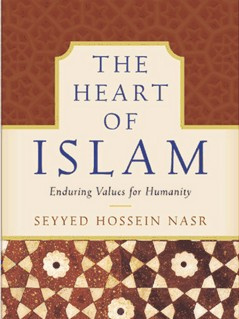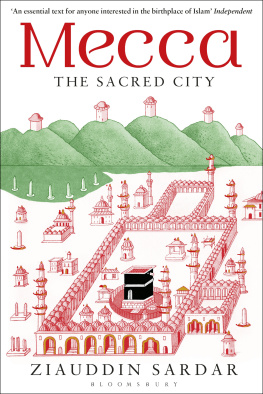
In the Name of God, the Infinitely Good, the All-Merciful
The Holiest Cities of Islam
And this is a Book which We have sent down full of blessings and confirming what [was revealed] before it: that thou mayest warn the Mother of Cities [Umm al-quraMecca] and its surroundings. Those who believe in the hereafter believe herein and they are constant in their prayers.
Quran, vi: 92, trans. Yusuf Ali, modified
Medina is best for them if they only knew. No one leaves it through dislike of it without God putting in it someone better than he in place of him, and no one will remain there in spite of its hardship and distress without my being an intercessor on his behalf on the day of resurrection.
Saying ( hadith ) of the Prophet of Islam, in Muhammad ibn Abd Allah Khatib al-Tibrizi, Mishkat al-Masabih , trans. James Robson, Lahore: Muhammad Ashraf, 1981, pp. 5867
Two events, which in fact are two aspects of the same reality, cast the cities of Mecca (Makkah) and Medina (Madinah) in a short period upon the pages of world history. These events were the birth in AD 570, the maturity and prophethood of Muhammad ibn Abd Allahpeace and blessings be upon himand the descent of the Quranic revelation upon him during a 23-year period from 610 until his death in 632. These events of cosmic proportions established Islam, the last plenary religion of humanity, upon the earth, thereby transforming not only the history of Arabia or of the Mediterranean basin and the Persian and Byzantine Empires, but also of lands as far away as France and the Philippines and, ultimately, the whole of the globe. The revelation of the Noble Quran, the verbatim Word of God for Muslims, began in Mecca where the Blessed Prophet was born and continued in Medina where he died. The very landscape of these two cities still reverberates with the grace ( barakah ) of the revelation and echoes the presence of that most perfect human being who was chosen by God to receive His last message and thereby to bring to completion the cycle of prophecy which had begun with Adam himself.
Mecca the Blessed ( al-Makkat al-mukarramah ) and Medina the Radiant ( al-Madinat al-munawwarah ), as they are known to Muslims, became intertwined by the very events of the Islamic revelation. Mecca, the city where the primordial Temple and House of God, the Kabah, is situated, was where the Prophet was born and raised while Medina became his city by virtue of his migration there in AD 622, which marks the beginning of the Islamic calendar. The very name Medina, which in Arabic means simply city, is, in fact, the abbreviation of Madinat al-nabi, the City of the Prophet, which replaced the older name of Yathrib after the Blessed Prophet migrated to that city where he established the first Islamic community and the first mosque.
The testimony whereby a person embraces Islam is simply la ilaha illaLlah (there is no divinity but Allah) and Muhammadun rasul Allah (Muhammad is the messenger of God), Allah being simply the Arabic word for God considered in His absolute Oneness beyond all hypostatic differentiations. These two formulas are inseparable in Islamic life and are seen by Muslims as being inwardly united. One may say that such is also the case of Mecca and Medina, the two holy centers of Islam, whose significance is inseparable in the religious life and thought of Muslims. Mecca is primarily the city of God by virtue of the Kabah and may be said to correspond to la ilaha illaLlah, while Medina, where the Mosque of the Prophet and his tomb are to be found, is of course primarily the city of the Prophet and corresponds to Muhammadun rasul Allah. And in the same way that five times a day the call to prayer ( al-adhan ), heard from minarets and rooftops as well as in streets and houses throughout the Islamic World, announces the two testimonies of faith together, the barakah and significance of those holy cities remain organically united. At the same time, their influence, and the second by virtue of the first, has over the centuries dominated not only the heart-land of Islam in Arabia but all Islamic lands near and far, and love for them is cherished in the hearts of men and women of all different races and climes where there has been a positive response to the call to unity ( al-tawhid ) of the Islamic message.
The Arabian Peninsula
The peninsula of Arabia is located at the crossroad of three continents, Asia, Africa and Europe, its northern regions neighboring the Mediterranean world, its eastern realms Persia, and its southern shores Africa, with which it has always enjoyed close links in trade, migration of ideas and also people, as it has with its other neighbors. The southern region of the peninsula, home to ports through which goods were brought from the Indian Ocean, has always been more green than the north and was the home of many ancient civilizations. Its people, who considered themselves descendants of Qahtan, became known for the wonderful plants and perfumes that they cultivated. The frankincense and myrrh of southern Arabia were so well known in the Roman Empire that the Romans called this region Arabia Odorifera. It is sufficient to think of the Queen of Sheba and her world to recall the great regard that peoples of antiquity held for the high civilizations of southern Arabia.
As for the northern part of the peninsula, it was adjacent to the great Semitic civilizations of Mesopotamia, the influence of whose art is to be seen in the artifacts found in the north. Later, there were also close contacts with the Persian and Byzantine Empires. In the centuries between the rise of Christianity and the advent of Islam, there were, in fact, local kingdoms in the north such as the Nabataean and the Ghassanid which exercised influence upon certain aspects of the cultures of Arabia, the latter having been Christian.
The heartland of Arabia, consisting of Hijaz and Najd, continued, however, to be dominated mostly by Arab nomads who had remained on the margin of the major historical developments to their north and were not greatly influenced by either Judaism or Christianity despite the presence of members of both communities in the cities of Arabia. As far as Hijaz, the sacred land in which Mecca and Medina are located, is concerned, it is the name of the western region of the Arabian peninsula, consisting of a fairly narrow tract of land about 1,400 kilometers long east of the Red Sea with the Tropic of Cancer running through its center. The land is called Hijaz, meaning barrier, because its back -bone, the Sarat Mountains, running parallel to the Red Sea, separates the flat coastal area called Tihamah from the highlands of Najd. The Sarat Mountains consist of volcanic peaks and natural depressions, creating a stark and rugged environment dominated by intense sunlight and with little rain. And it is in one of the natural depressions of this mountain range that is to be found the sacred city of Mecca, the hub of the earth and its center for the descendants of Ismail (the biblical Ishmael).
Arabia is dominated by deserts that before modern times could not be crossed except with the help of camels which, therefore, became indispensable to the life of its people. The population centers have always been situated around wells and springs in the desert which have created the oases for which certain desert areas are well known. The majority of the population of Arabia consisted of nomads, although cities such as Mecca existed in Arabia even before the rise of Islam. It was, however, only during the twentieth century that the vast majority of the nomads of Arabia became sedentarized and attempts were made to use the vast underground water sources of the peninsula to create agriculture for the settled nomads. Throughout history, the Arabs, the descendants of lshmael (Ismail), were mostly nomads of Semitic stock. Something essential of the spiritual dimension of Semitic nomadism was, in fact, adopted by Islam and has therefore become a basic aspect of the spiritual universe of all Muslims.

















